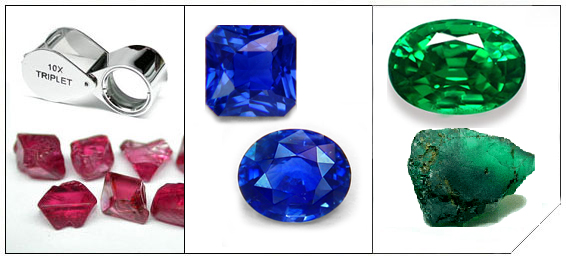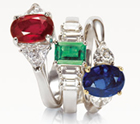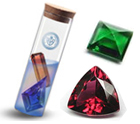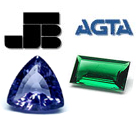GEMSTONE GUIDE | RUBY EMERALD SAPPHIRE EDUCATION
Ruby Facts & Ruby Rings | Emerald Facts & Emerald Rings | Sapphire Facts & Sapphire Rings.


A prior knowledge of gemstones (ruby, emerald and sapphire) will help you understand and retain what a jeweler tells you. This gemstone guide will help you in evaluating the quality of ruby, emerald and sapphire, an aid in avoiding fraud with information on immitation (synthetic and treatment), as a handy reference on colored gemstones, provide a collection of practical tips on choosing and caring for gems and a challenge to view colored gemstones through the eyes of gemologists and gem dealers. When gemologists speak of shape, they usually mean its face up outline. The most common gemstone shapes include round, oval, square, pears, marquise and octogon. To learn more Click Here.

Enhancement is often used as another word for treatment. Enhancement also refers to the faceting and polishing of a gem. For centuries, ruby, emerald and sapphire have been in heat treated to improve their color. Heat treating is widely accepted because it is a continuation of a natural process and it causes a permanent improvement of the entire gemstone. From the standpoint of value, it does not matter whether commercially-quality stones have been treated or not as long as the color is permanent. The overall quality of the treated stone will determine the price. However, a premium may be charged for high-quality untreated stones that comes with a lab report stating there is no evidence of heat treatment.

American Gemological Society: Since 1934, American Gem Society (AGS) has been protecting the consumers. For 70 years, the AGS logo has been a symbol of excellence in the jewelry industry. As an association of fine jewelers, our members are committed to the highest ethics, and practice truth-in-advertising and pricing. To visit AGS website Click Here. AGS is located at 181 World Trade Center, 2050 Stemmons Expressway, Dallas, TX 75027 and their telephone number is 809-972-1162. Jewelers Board of Trade: We are proud member of the Jewelers Board of Trade (JBT). To visit their website Click Here.
Enhancements: Unpolished gemstones are typically very rough. Looking at gemstones straight from the mine, they might be mistaken for pebbles or gravel.
Nearly all gemstones available on the open market have been "enhanced" (i.e. something has been done to make them look better). Gemstones that have not been enhanced are very rare and command extravagant prices.
There are many methods of enhancing gemstones. Some of the most common enhancement treatments are described below. For more information on gemstone enhancements, visit the American Gem Trade Association website
The use of heat to enhance the color of some gemstones is a common practice around the globe and has been going on for centuries. It is part of the standard polishing and finishing process for many gemstone varieties, including aquamarine, citrine, amethyst, sapphire, ruby and tanzanite, and is accepted by the jewelry industry and the American Gem Trade Association.
The enhanced color of heat-treated gemstones is permanent and does not require special care. Aquamarine, citrine, amethyst, sapphire, ruby and tanzanite gemstones offered by Blue Nile have been heat treated.
Colorless oil, wax and resin are used to improve the clarity of some gemstones. The colorless oil, wax or resin is infused into surface-reaching fissures (called inclusions) to improve the stone's appearance. This process began centuries ago by gemstone merchants who found that immersing emeralds in clear oil or waxes made them look clearer to the unaided eye. Today, almost all emeralds are treated in this way. Gemstones with colorless oil, wax or resin enhancement, including emeralds, can be harmed if handled roughly. Recommended special care for such gemstones is avoidance of sudden temperature changes, steaming, chemicals and ultrasonic exposure.
Emeralds offered by Sndgems.com may have been treated with colorless oil, wax or resin.
Unique Diamond & Gemstone Eternity Rings Guide: Page 1, 2, 3, 4, 5, 6, 7, 8, 9, 10, 11, 12, 13, 14, 15, 16, 17, 18, 19, 20, 21, 22, 23, 24, 25, 26, 27, 28, 29, 30, 31, 32, 33.
The "celestial" sapphire, symbol of the heavens, bestower of innocence, truth, good health, and preserver of chastity, is reserved today as the birthstone of September. To learn more Click Here. Guide to Fancy Sapphire Engagement Rings: Page 1, 2, 3, 4, 5, 6, 7, 8, 9, 10, 11, 12, 13, 14. M o r e Page 1, 2, 3, 4, 5, 6, 7, 8, 9, 10, 11.
The word "ruby" derives from the Latin word rubeus, which means red. Ruby is the name given to the red variety of corundum. To learn more Click Here. Guide to Ruby Engagement Rings: Page 1, 2, 3, 4, 5, 6, 7, 8, 9. Ruby Engagement Ring Guide: Page 1, 2, 3, 4, 5, 6, 7, 8, 9.
Emerald is the green variety of the mineral beryl used in emerald rings. Physical Properties: Emerald Color: Emerald Green, green and yellowish green; Emeralds Moh's Hardness: 7.5-8; Emeralds Density: 2.67-2.78; Emerald Chemical Composition: Aluminium Berrylium Silicate; Emeralds Transparency: Transparent to Opaque; Emeralds Refractive Index: 1.565-1.602; Emeralds Dispersion: 0.014; Emeralds Pleochroism: Definite; green, blue, blue green to yellow green. To learn more Click Here.

Why Buy From Us | References | Site Security | Guarantee | Return Policy | Buyer's Tips | FAQ | Site Map Product Education | Live Online Help | Search Our Website | Customer Service | Contact Us | Payment Options | Sales TaxShipping Charges | Service Center | Order Tracking | Platinum Facts | Ring Sizing | Engraving Options | PolishingHow To Order | After Sales Service | Legal | Terms & Conditions | Disclaimer | Product Policies | Security